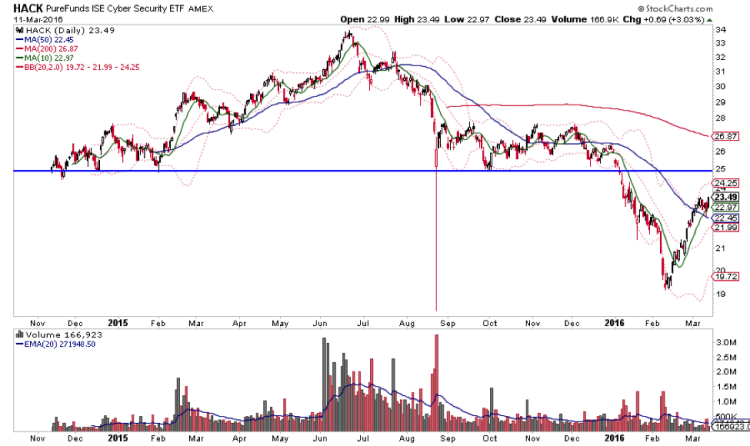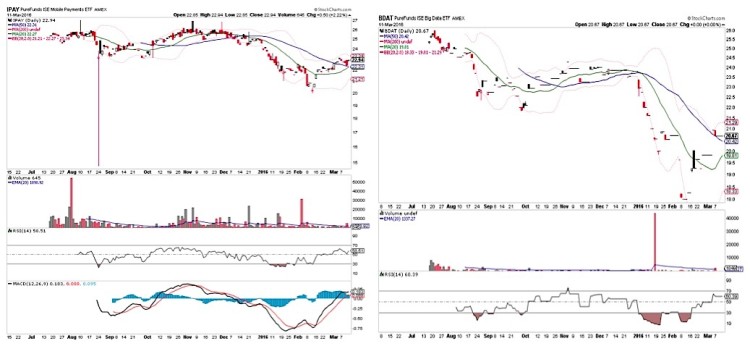The technology sector is overflowing with opportunity as investors grasp some of the most innovative companies on the planet. While some may choose to latch on to individual stocks like Apple Inc (AAPL) or Facebook Inc (FB), there are also opportunities to invest in industry groups as well. But investors need to understand what they’re investing in when they buy technology ETFs.
Even more so when looking at “select” technology ETFs.
A new breed of exchange-traded funds termed “select tech” are designed to hone in on a similar group of niche technology stocks in a particular industry. The benefit is that you get instant diversification in this theme rather than having to rely on individual stock picking. However, there are some drawbacks to this method that we will discuss further as well.
KNOW WHAT YOU OWN: SELECT TECHNOLOGY ETFs
Reviewing The Playing Field – David Fabian
One of the most successful pioneers in this breed is the PureFunds ISE Cyber Security ETF (HACK). This fund debuted in 2014 amid a multi-pronged news cycle of online security breaches and cyber attacks that helped propel it into the spotlight.
HACK invests in a basket of 35 publicly traded companies around the globe that focus on network security, hacker prevention, and identity theft. Top holdings hardware and software stocks such as: AVG Technologies (AVG), Cisco Systems (CSCO), and Check Point Software (CHKP).
This select technology ETF has managed to garner $735 million in total assets and charges an expense ratio of 0.75%. The one area that I may be overly critical of this fund is its expense ratio, which rests on the high side of the industry average. Nevertheless, it should be expected that a relatively unique fund with a niche strategy will charge more for its services than a typical broad-based index.
Pure Funds has also recently launched new funds that focus on big data, video games, drone technology, and mobile payments. These select technology ETFs / funds include:
PureFunds ISE Big Data ETF (BDAT) – 32 holdings
PureFunds Video Game Tech ETF (GAMR) – 36 holdings
PureFunds Drone Economy Strategy ETF (IFLY) – 44 holdings
PureFunds ISE Mobile Payments ETF (IPAY) – 31 holdings
Most of these technology ETFs are still new to the market and have yet to have time to acquire assets, trading history, and volume. They all charge a similar expense ratio of 0.75% as well.
Investors considering these funds should account for a few variables in their cost/benefit analysis. Primarily the fact that these funds will likely experience heighted volatility and periods of divergence to the broad technology sector given their focused nature. The smaller number of holdings means that they will likely be more appropriate for aggressive, growth-oriented investors who want to access a specific theme and understand these risks.
In my opinion, these funds are only appropriate as tactical positions, which means holding sizes should be kept smaller than core positions that invest in a broader group of sectors. Furthermore, the above-average expense ratio may play a factor in your decision of whether or not these are appropriate to enhance your specific portfolio.
Technical Review – Aaron Jackson
Like many investment products, HACK came to market when there was insatiable demand and hype.
The IPO support area of 24-25 was breached early in the year and is the most important level on the chart.
Similar to HACK, IPAY and BDAT came public following years of excellent performance in popular market niches. These themes are still attractive moving forward, but it’s for funds to grow when it’s pushed to the public like this.
Sometimes, ETFs can just be used as a barometer of a group of stocks. For now that’s the case with GAMR and IFLY.
Let’s take the newly introduced video game ETF as an example. It’s a great way to track some of the leading companies in video game space.
One might also think this fund could be a great way to play Virtual Reality. It may be, but the fund doesn’t include Alphabet Inc or Facebook and it’s Oculus platform.
Conclusions
- Specialty technology ETFs (and other niches) are generally created due to excessive demand by investors chasing returns.
- When that happens, these popular groups tend to lag the market in the intermediate term future.
- These funds can be better used as a barometer of a group of stocks. As of now, only Cyber Security Fund HACK is investable.
Thanks for reading!
This article is part of a series co-authored by David Fabian (fmdcapital.com) and Aaron Jackson (northstarta.com). Each week we will be unlocking the secrets to some of the most talked-about exchange-traded funds in the market. The goal is to better understand what you own or elevate new ideas to the forefront of your watch list.
Twitter: @fabiancapital @ATMCharts
Neither author holds a position in the mentioned securities at the time of publication. Any opinions expressed herein are solely those of the authors, and do not in any way represent the views or opinions of each other or any other person or entity.









